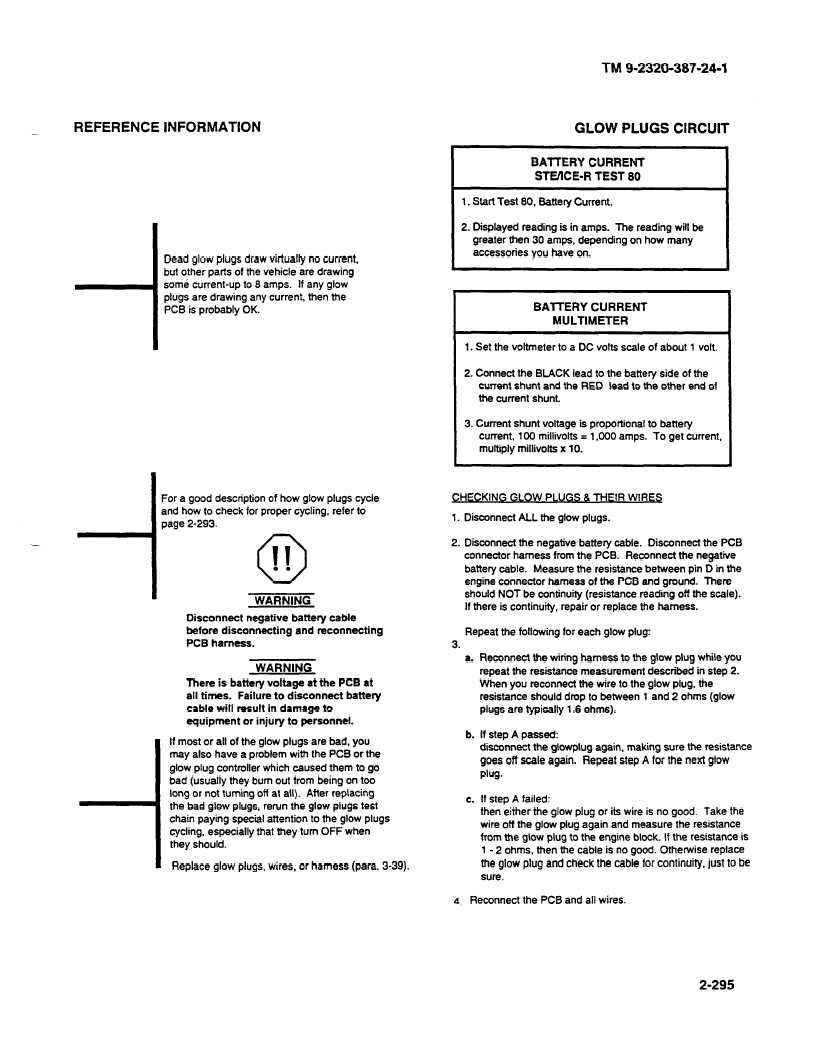TM 9-2320-387-24-I
REFERENCE INFORMATION
GLOW PLUGS CIRCUIT
Dead glow plugs draw virtually no current,
but other parts of the vehicle are drawing
some current-up to 8 amps. If any glow
plugs are drawing any current, then the
PCB is probably OK.
I
For a good description of how glow plugs cycle
and how to check for proper cycling, refer to
page 2-293.
--I
@
WARNING
Disconnect
negative
battery
cable
before disconnecting
and reconnecting
PCB harness.
WARNING
There is battery voltage at the PCB at
all times. Failure to disconnect
battery
cable will nsult
in damage to
equipment or injury to Personnel.
If most or all of the glow plugs are bad, you
may also have a problem with the PCB or the
glow plug controller which caused them to go
bad (usually they bum out from being on too
long or not turning off at all). After replacing
the bad glow plugs, rerun the glow plugs test
chain paying special attention to the glow plugs
cycling, especially that they turn OFF when
they should.
1
Replace glow plugs, wires, or harness (para. 3-39).
BATTERY CURRENT
STE’ICE-R TEST 80
1. Start Test 80. Battery Current.
2. Displayed reading is in amps. The reading will be
greater then 30 amps, depending on how many
accessories you have on.
BATTERY CURRENT
MULTIMETER
1. Set the voltmeter to a DC volts scale of about 1 volt.
2. Connect the BLACK lead to the battery side of the
current shunt and the RED lead to the other end of
the current shunt.
3. Current shunt voltage is proportional to battery
current, 100 millivolts = 1.000 amps. To get current,
multiply millivolts x 10.
CHECKING GLOW PLUGS 8 THEIR WIRFS
1. Disconnect ALL the glow plugs.
2. Disconnect the neoative battery cable. Disconnect the PCB
connector harnessfrom
the PdB.
Reconnect the negative
battery cable. Measure me resistance between pin D in the
engine connector harness of the PCB and ground. There
should NOT be continuity (resistance reading off the scale).
If there is continuity, repair or replace me harness.
Repeat the following for each glow plug:
3.
a. Reconnect the wiring harness to the glow plug while you
repeat the resistance measurement described in step 2.
When you reconnect the wire to the glow plug, the
resistance should drop to between 1 and 2 ohms (glow
plugs are typically 1.6 ohms).
b. If step A passed:
disconnect the glowptug again, making sure the resistance
goes off scale again. Repeat step A for me next glow
plug.
C.
If step A failed:
then either the glow plug or its wire is no good. Take the
wire off the glow plug again and measure the resistance
from the glow plug to the engine block. If the resistance is
1 - 2 ohms, then the cable is no good. Otherwise replace
the glow plug and check the cable for continuity, just to be
sure.
4. Reconnect the PCB and all wires.
2-295

